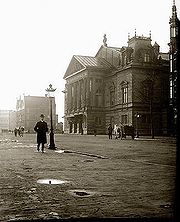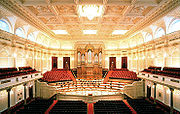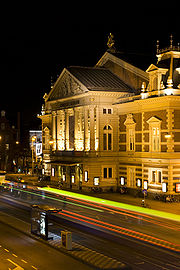
Concertgebouw
Encyclopedia

Amsterdam
Amsterdam is the largest city and the capital of the Netherlands. The current position of Amsterdam as capital city of the Kingdom of the Netherlands is governed by the constitution of August 24, 1815 and its successors. Amsterdam has a population of 783,364 within city limits, an urban population...
, Netherlands
Netherlands
The Netherlands is a constituent country of the Kingdom of the Netherlands, located mainly in North-West Europe and with several islands in the Caribbean. Mainland Netherlands borders the North Sea to the north and west, Belgium to the south, and Germany to the east, and shares maritime borders...
. The Dutch term "concertgebouw" literally translates into English as "concert building". Because of its highly regarded acoustics
Architectural acoustics
Architectural acoustics is the science of noise control within buildings. The first application of architectural acoustics was in the design of opera houses and then concert halls. More widely, noise suppression is critical in the design of multi-unit dwellings and business premises that generate...
, the Concertgebouw is considered one of the finest concert halls in the world, along with places such as Buenos Aires' Teatro Colón, Boston's Symphony Hall
Symphony Hall, Boston
Symphony Hall is a concert hall located at 301 Massachusetts Avenue in Boston, Massachusetts. Designed by McKim, Mead and White, it was built in 1900 for the Boston Symphony Orchestra, which continues to make the hall its home. The hall was designated a U.S. National Historic Landmark in 1999...
and the Musikverein
Musikverein, Vienna
Wiener Musikverein, , commonly shortened to The Musikverein, has a twofold meaning: it is the name of a famous Vienna concert hall, as well as the short name for the music society, Gesellschaft der Musikfreunde [Society of Music Friends], that owns the building.This building is located on...
in Vienna.
History

Gewandhaus
Gewandhaus is a concert hall in Leipzig, Germany. Today's hall is the third to bear this name; like the second, it is noted for its fine acoustics. The first Gewandhaus was built in 1781 by architect Johann Carl Friedrich Dauthe. The second opened on 11 December 1884, and was destroyed in the...
in Leipzig
Leipzig
Leipzig Leipzig has always been a trade city, situated during the time of the Holy Roman Empire at the intersection of the Via Regia and Via Imperii, two important trade routes. At one time, Leipzig was one of the major European centres of learning and culture in fields such as music and publishing...
, built two years earlier (and destroyed in 1943).
Construction began in 1883 in a pasture that was then outside the city, in Nieuwer-Amstel, a municipality that in 1964 became Amstelveen
Amstelveen
' is a suburban municipality in the Netherlands, in the province of North Holland. It is part of the metropolitan area of Amsterdam. The municipality of Amstelveen consists of the following villages and/or districts: Amstelveen, Bovenkerk, Westwijk, Bankras-Kostverloren, Groenelaan, Waardhuizen,...
. 2,186 piles twelve to thirteen meters (forty to forty-three feet) in length were sunk into the soil.

Richard Wagner
Wilhelm Richard Wagner was a German composer, conductor, theatre director, philosopher, music theorist, poet, essayist and writer primarily known for his operas...
, Handel
George Frideric Handel
George Frideric Handel was a German-British Baroque composer, famous for his operas, oratorios, anthems and organ concertos. Handel was born in 1685, in a family indifferent to music...
, Bach
Johann Sebastian Bach
Johann Sebastian Bach was a German composer, organist, harpsichordist, violist, and violinist whose sacred and secular works for choir, orchestra, and solo instruments drew together the strands of the Baroque period and brought it to its ultimate maturity...
, and Beethoven
Ludwig van Beethoven
Ludwig van Beethoven was a German composer and pianist. A crucial figure in the transition between the Classical and Romantic eras in Western art music, he remains one of the most famous and influential composers of all time.Born in Bonn, then the capital of the Electorate of Cologne and part of...
. The resident orchestra of the Concertgebouw is the Royal Concertgebouw Orchestra
Royal Concertgebouw Orchestra
The Royal Concertgebouw Orchestra is a symphony orchestra of the Netherlands, based at the Concertgebouw in Amsterdam. In 1988, Queen Beatrix of the Netherlands conferred the "Royal" title upon the orchestra...
(Koninklijk Concertgebouworkest), which gave its first concert in the hall on 3 November 1888, as the Concertgebouw Orchestra (Concertgebouworkest).


Gustav Mahler
Gustav Mahler was a late-Romantic Austrian composer and one of the leading conductors of his generation. He was born in the village of Kalischt, Bohemia, in what was then Austria-Hungary, now Kaliště in the Czech Republic...
. Though this characteristic makes it largely unsuited for amplified music, groups such as Led Zeppelin
Led Zeppelin
Led Zeppelin were an English rock band, active in the late 1960s and throughout the 1970s. Formed in 1968, they consisted of guitarist Jimmy Page, singer Robert Plant, bassist/keyboardist John Paul Jones, and drummer John Bonham...
, The Who
The Who
The Who are an English rock band formed in 1964 by Roger Daltrey , Pete Townshend , John Entwistle and Keith Moon . They became known for energetic live performances which often included instrument destruction...
& Pink Floyd
Pink Floyd
Pink Floyd were an English rock band that achieved worldwide success with their progressive and psychedelic rock music. Their work is marked by the use of philosophical lyrics, sonic experimentation, innovative album art, and elaborate live shows. Pink Floyd are one of the most commercially...
performed there in the 1960s. Furthermore, Paul McCartney
Paul McCartney
Sir James Paul McCartney, MBE, Hon RAM, FRCM is an English musician, singer-songwriter and composer. Formerly of The Beatles and Wings , McCartney is listed in Guinness World Records as the "most successful musician and composer in popular music history", with 60 gold discs and sales of 100...
mentions it in his song "Rock Show". In addition to orchestras, jazz and world music groups perform in the Grote Zaal. Concert performances of opera
Opera
Opera is an art form in which singers and musicians perform a dramatic work combining text and musical score, usually in a theatrical setting. Opera incorporates many of the elements of spoken theatre, such as acting, scenery, and costumes and sometimes includes dance...
also take place there.
A smaller, oval-shaped venue, the Kleine Zaal ("Small Hall"), is located behind the main hall. The Kleine Zaal is 20 meters (66 ft) long and 15 meters (50 ft) wide. Its more intimate space is well-suited for chamber music
Chamber music
Chamber music is a form of classical music, written for a small group of instruments which traditionally could be accommodated in a palace chamber. Most broadly, it includes any art music that is performed by a small number of performers with one performer to a part...
and lieder. The Kleine Zaal has 478 seats.
When the Concertgebouw was built, acoustics
Architectural acoustics
Architectural acoustics is the science of noise control within buildings. The first application of architectural acoustics was in the design of opera houses and then concert halls. More widely, noise suppression is critical in the design of multi-unit dwellings and business premises that generate...
were something of a black art. As in shipbuilding, designers drew upon what had worked in the past without entirely understanding the underlying science (which even today is still not well understood). When the building was completed, the acoustics were not perfect, and a lot of effort went into fine-tuning the aural ambience. During later restorations, particular care has been taken not to alter the materials used for interior decoration with this in mind. In the 1980s, the hall embarked on extensive fund-raising for renovations after the hall was found to be slowly sinking into the ground. Pi de Bruijn
Pi de Bruijn
Pi de Bruijn is a Dutch architect who won the second prize in February 1993 for the competition on the Reichstag the highest German government building. Office de Architecten Cie., Amsterdam...
was the architect for the contemporary annex to the original hall.
Today, some nine hundred concerts per year take place in the Concertgebouw, for a public of over 800,000, making it the second most-visited concert hall in the world (Rome's Parco della musica
Parco della Musica
Auditorium Parco della Musica is a large multi-functional public music complex in Rome, Italy. The complex is situated in the north of the city, in the area where the 1960 Summer Olympic Games were held....
ranking N. 1 with over one million).
The current managing director of the Concertgebouw is Simon Reinink. The hall's current artistic director is Anneke Hogenstijn.
Names of composers in the Grote Zaal
In the Grote Zaal, the family names of a number of classical music composers are displayed on the balcony ledges and on the walls. These composers include the following:
|
Jean-Baptiste Lully Jean-Baptiste de Lully was an Italian-born French composer who spent most of his life working in the court of Louis XIV of France. He is considered the chief master of the French Baroque style. Lully disavowed any Italian influence in French music of the period. He became a French subject in... Domenico Scarlatti Giuseppe Domenico Scarlatti was an Italian composer who spent much of his life in the service of the Portuguese and Spanish royal families. He is classified as a Baroque composer chronologically, although his music was influential in the development of the Classical style... Wolfgang Amadeus Mozart Wolfgang Amadeus Mozart , baptismal name Johannes Chrysostomus Wolfgangus Theophilus Mozart , was a prolific and influential composer of the Classical era. He composed over 600 works, many acknowledged as pinnacles of symphonic, concertante, chamber, piano, operatic, and choral music... Luigi Cherubini Luigi Cherubini was an Italian composer who spent most of his working life in France. His most significant compositions are operas and sacred music. Beethoven regarded Cherubini as the greatest of his contemporaries.... Carl Maria von Weber Carl Maria Friedrich Ernst von Weber was a German composer, conductor, pianist, guitarist and critic, one of the first significant composers of the Romantic school.... Hector Berlioz Hector Berlioz was a French Romantic composer, best known for his compositions Symphonie fantastique and Grande messe des morts . Berlioz made significant contributions to the modern orchestra with his Treatise on Instrumentation. He specified huge orchestral forces for some of his works; as a... Frédéric Chopin Frédéric François Chopin was a Polish composer and virtuoso pianist. He is considered one of the great masters of Romantic music and has been called "the poet of the piano".... Franz Liszt Franz Liszt ; ), was a 19th-century Hungarian composer, pianist, conductor, and teacher.Liszt became renowned in Europe during the nineteenth century for his virtuosic skill as a pianist. He was said by his contemporaries to have been the most technically advanced pianist of his age... Richard Wagner Wilhelm Richard Wagner was a German composer, conductor, theatre director, philosopher, music theorist, poet, essayist and writer primarily known for his operas... Charles Gounod Charles-François Gounod was a French composer, known for his Ave Maria as well as his operas Faust and Roméo et Juliette.-Biography:... Carl Reinecke Carl Heinrich Carsten Reinecke was a German composer, conductor, and pianist.-Biography:Reinecke was born in Altona, Hamburg, Germany; until 1864 the town was under Danish rule. He studied with his father, Johann Peter Rudolph Reinecke, a music teacher... Cornelis Schuyt Cornelis Floriszoon Schuyt was a Dutch organist and Renaissance composer.Cornelis Floriszoon Schuyt was born in Leiden in 1557... |
Jacob Obrecht Jacob Obrecht was a Flemish composer of the Renaissance. He was the most famous composer of masses in Europe in the late 15th century, being eclipsed by only Josquin des Prez after his death.-Life:... Jan Pieterszoon Sweelinck Jan Pieterszoon Sweelinck was a Dutch composer, organist, and pedagogue whose work straddled the end of the Renaissance and beginning of the Baroque eras. He was among the first major keyboard composers of Europe, and his work as a teacher helped establish the north German organ... Pyotr Ilyich Tchaikovsky Pyotr Ilyich Tchaikovsky Pyotr Ilyich Tchaikovsky Pyotr Ilyich Tchaikovsky (Russian: Пётр Ильи́ч Чайко́вский ; often "Peter Ilich Tchaikovsky" in English. His names are also transliterated "Piotr" or "Petr"; "Ilitsch", "Il'ich" or "Illyich"; and "Tschaikowski", "Tschaikowsky", "Chajkovskij"... Igor Stravinsky Igor Fyodorovich Stravinsky ; 6 April 1971) was a Russian, later naturalized French, and then naturalized American composer, pianist, and conductor.... Johan Wagenaar Johan Wagenaar was a Dutch composer and organist.-Life:Born in Utrecht, out of wedlock, he was the son of Cypriaan Gerard Berger van Hengst and Johanna Wagenaar. Wagenaar's parents were of different social strata: his father was an aristocrat, while his mother was of more humble origins... Max Reger Johann Baptist Joseph Maximilian Reger was a German composer, conductor, pianist, organist, and academic teacher.-Life:... Maurice Ravel Joseph-Maurice Ravel was a French composer known especially for his melodies, orchestral and instrumental textures and effects... Willem Pijper Willem Pijper ; Zeist, 8 September 1894 - Utrecht, 18 March 1947) was a Dutch composer, music critic and music teacher.-Life:Pijper was born at Zeist, near Utrecht, on 8 September 1894 of strict Calvinist working-class parents. His father, who sometimes played psalm accompaniments on the harmonium,... Franz Schubert Franz Peter Schubert was an Austrian composer.Although he died at an early age, Schubert was tremendously prolific. He wrote some 600 Lieder, nine symphonies , liturgical music, operas, some incidental music, and a large body of chamber and solo piano music... Felix Mendelssohn Jakob Ludwig Felix Mendelssohn Barthóldy , use the form 'Mendelssohn' and not 'Mendelssohn Bartholdy'. The Grove Dictionary of Music and Musicians gives ' Felix Mendelssohn' as the entry, with 'Mendelssohn' used in the body text... |
Robert Schumann Robert Schumann, sometimes known as Robert Alexander Schumann, was a German composer, aesthete and influential music critic. He is regarded as one of the greatest and most representative composers of the Romantic era.... Johannes Verhulst Johannes Joseph Hermann Verhulst was a Dutch composer and conductor. As a composer mainly of songs and as administrator of Dutch musical life, his influence during his lifetime was considerable.-Life:As a boy, Verhulst sang in a catholic choir; here he distinguished himself by his gift for music... Anton Rubinstein Anton Grigorevich Rubinstein was a Russian-Jewish pianist, composer and conductor. As a pianist he was regarded as a rival of Franz Liszt, and he ranks amongst the great keyboard virtuosos... Louis Spohr Louis Spohr was a German composer, violinist and conductor. Born Ludewig Spohr, he is usually known by the French form of his name. Described by Dorothy Mayer as "The Forgotten Master", Spohr was once as famous as Beethoven. As a violinist, his virtuoso playing was admired by Queen Victoria... Ludwig van Beethoven Ludwig van Beethoven was a German composer and pianist. A crucial figure in the transition between the Classical and Romantic eras in Western art music, he remains one of the most famous and influential composers of all time.Born in Bonn, then the capital of the Electorate of Cologne and part of... Johannes Brahms Johannes Brahms was a German composer and pianist, and one of the leading musicians of the Romantic period. Born in Hamburg, Brahms spent much of his professional life in Vienna, Austria, where he was a leader of the musical scene... Joseph Haydn Franz Joseph Haydn , known as Joseph Haydn , was an Austrian composer, one of the most prolific and prominent composers of the Classical period. He is often called the "Father of the Symphony" and "Father of the String Quartet" because of his important contributions to these forms... Johann Sebastian Bach Johann Sebastian Bach was a German composer, organist, harpsichordist, violist, and violinist whose sacred and secular works for choir, orchestra, and solo instruments drew together the strands of the Baroque period and brought it to its ultimate maturity... |
See also
- Royal Concertgebouw OrchestraRoyal Concertgebouw OrchestraThe Royal Concertgebouw Orchestra is a symphony orchestra of the Netherlands, based at the Concertgebouw in Amsterdam. In 1988, Queen Beatrix of the Netherlands conferred the "Royal" title upon the orchestra...
- History of AmsterdamHistory of AmsterdamAmsterdam has a long and eventful history. The origins of the city lie in the 13th century, when fisherman living along the banks of the River Amstel built a bridge across the waterway near the IJ, then a large saltwater inlet. Wooden doors on the bridge served as a dam; these protected the town...
- List of concert halls
- Amsterdam Tourist Attractions
External links
- Concertgebouw website
- Archive of the Concertgebouw at the Amsterdam City Archives

